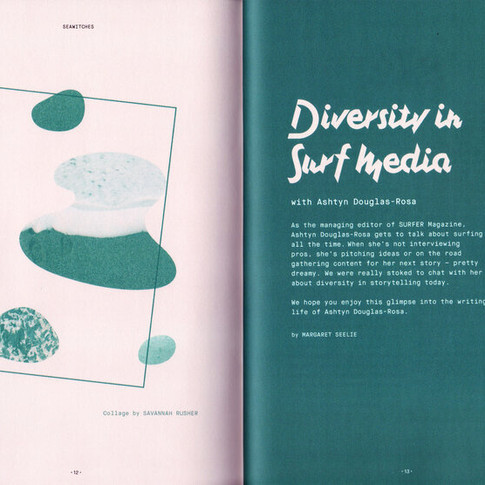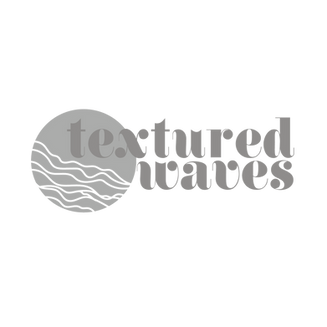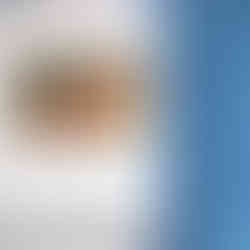Spells & Swells with Seawitch Margaret
- dreamcannon

- Jan 25, 2021
- 9 min read
Updated: Nov 4
The SEAWITCHES unify water people. Who are they? They are the kids who never want to get out of the swimming pool, the ocean swimmers, the surfers, the deep-down water lovers. Raised in a family of sailors, Margaret grew up on Lake Erie, swimming at night, and was always on the water. Margaret believes, “If we don’t care for the waves, they won’t be there.”

Why Witches?
I’ve always been interested in the Other, and witches are definitely Others. In case you’re not familiar, the concept of the Other is a theory Simone de Beauvoir introduced in the 50s. It’s about how men are considered the norm within society; thus women are the Other. Basically, women exist only within the context of their relationship to a man.
Today, if you’re not a straight white man you are the Other.
I chose names for my projects like The OTHER Project, The Other Side of Surfing, and Seawitches because they are all attempting to have a dialogue with this otherness. Helping womxn, BIPOC, LGBTQI+ folx, people from other cultures, allies, and yes some straight white men share their stories that shift our narrative, even just a little, is how we move mountains together. Ultimately, it’s about building a wave of these stories, so many that they become the norm. Helping each other to create our own narratives and lexicons.
Witches are also magical and connected to nature, which is what we need to build the future we want. I think it’s hopeful.
What was/were the (or many) inspiring moment (s) that led you to start this zine?
BACK IN THE '90s, when I was 15 or 16, I wanted to make a music zine. I was going to shows and interviewing punk bands like Fifteen and Discount with my little cassette tape recorder. It was so fun getting to meet my idols. But I also didn’t know how to make a zine, and I remember being scared that people would think it was stupid. I never made my music zine.

FAST-FORWARD TO 2015.
I organized and moderated a panel discussion with four women in the surf industry called “The Other Side of Surfing”. I was joined by Ashley Lloyd, Julie Cox, Bianca Valenti, and Tiffany Campbell.
AFTER THE EVENT, people started contacting me, asking when the next discussion or event would be. It seemed that I had started a conversation that the community wanted to continue. I remember one person wanted to meet up for coffee. During our meeting, I found out they were approaching gender reassignment surgery. They were a surfer and wanted to know if I knew of any magazines or communities for transgender surfers. I had nothing to say and no stories to point them to. It felt horrible, and I wanted to change that.

IN 2017, I FINALLY PUBLISHED MY FIRST ZINE, Seawitches.
I still didn’t know what I was doing and worried about what people would think. I also had enough experiences such as, meeting a transgender surfer who showed me there was a need for this sort of space, and it overshadowed any fears I may have had. The release party for Seawitches was packed with wonderful people from the California surf scene, which was amazing and helped dispel many of my fears. Leah Koransky was our artist in residence for issue one, and she is now our designer. She is a large part of why we are still here today; I absolutely love creating with her. And our editor, Serena Renner, she’s amazing and such a joy to shape stories with.


SW3 contributors Natasha Brown and Marlim Reynosa + photos of Natasha Brown by Preston Richardson for Traveler
Tell us about your passion to use natural dyes and materials and your processes for printing the Seawitches Zine.
Leah taught me how to make paints and inks from nature. For issue 1, we said, “let’s try dying paper with indigo.” We totally loved it. It looked like an underwater abstract painting. We used eucalyptus bark to make this really pretty grey on issue 3. We just kept saying, “let’s just see if this thing works.” We fell in love with the process. Now we have seasonal color swatches that artists can choose from for their cover designs. Savannah Rusher was our artist in residence for issue 4, and she chose avocado pit pink for her covers.

Leah Koransky and Margaret make eucalyptus bark dye
Have you worked with these materials prior to Seawitches?
I had only used synthetic Rit dyes when I was a kid and some indigo dyeing. Leah has taught me everything about using these alternative materials and how to create colors with the seasons. I’m so grateful for her mentorship;
It’s helped me see the magic in nature.
What is the process like choosing an artist in residence and how long do those opportunities last at Seawitches? Is it just for one zine?
An artist in residence will collaborate for one zine. We reach out to a handful of people to see who might be the best fit for the issue. They get to collaborate with Leah and me on the cover design, so they pick the color they want the paper dyed and make a design. Once we land on the artwork, I letterpress print their creation. In non-Covid times, the artist was invited to dye and print with us. I’m looking forward to getting back to that.
(L) Collage by Savannah Rusher. Layout design by Leah Koransky. Artwork by Kate Barattini.

Tell us a little about Seawitches working at Open Windows Cooperative?
They are amazing not just as an art space but as a community. I’ve been letterpress printing the covers for Seawitches there since we started in 2017. And they hosted our first release party. Ava (Sayaka Rosen) is one of the founders and a friend. She’s done an amazing job of creating an inclusive and inspiring space.
Margaret's Journey to the West Coast Swells
When did you start surfing? Did you grow up in California?
I’m from Cleveland, Ohio. I didn’t grow up surfing, but my whole family loves the water, and we are all sailors. My mom and dad used to crew on the same boat, and when the sailing club tried to ban women from racing, my dad snuck my mom on board so she could sail. I guess I come from a long line of rule-benders and breakers, Ha!

As a kid, my bedroom was wallpapered with Roxy ads of girls hitting the lip on shortboards, fliers from shows, and X-Files posters. I was a nerd. In college, I studied abroad in Australia, and that was the first time I tried surfing. I was hooked.

After traveling around the world and living in China, I moved to San Francisco in 2009. Within a year, I went surfing for the second time at a beach south of the city. The conditions were awful, but I came out of the water glowing. I was so stoked. My friend told me that if I had fun in that jumbled mess, I would love real waves. I was so committed at first that I would take Bart to the bus to the surf shop to rent gear and just get in the water.
For years my surf journey was pretty lonely before I met some amazing water lovers.

Today, there are tons of great community groups for womxn, LGBTQI+, and BIPOC like Textured Waves, Dream Team Society, and GrlSwirl. Inclusive spaces like Traveler Surf Club and awesome brands like IDEAL Surf Co. It’s cool to see how far the lineup has come.
Can you tell me about your journey to beginning to write for brands like Athleta and Apple?
I wish Seawitches was my full-time job. To pay the bills, I’m a freelance writer. But prior to becoming a writer full time, I was a college professor. I used to teach English at San Francisco State and various community colleges. Then I worked full-time at Mills College in their academic support center. I loved teaching and my students. But then Mills hit a financial crisis, and I got laid off. That’s when I transitioned to full-time writing and working for big companies like Athleta, Adobe, and Apple.

As you know, we have a lot of aspiring writers and journalists that have joined withitgirl to seek opportunities they might not otherwise be given. What was the process of being picked by or submitting articles to magazines to write articles (including Jezebel, The Surfer’s Journal, SFist, M Magazine, and OPENHOUSE Magazine)? How did these opportunities come about?
Some of it was being in the right place at the right time. Other times, it was an instance of knowing someone.
But all of these opportunities were a direct result of initiative on my part. I’m constantly editing and adding to a list of stories I want to tell and publications or platforms where I want them to appear. If you don’t pitch your ideas or share them, they’ll never go anywhere.
Then get ready for a rejection letter, or more likely, nothing. I’ve been rejected or ignored so many times.
Sit down and make a list of any possible ways you could connect yourself to that magazine. Ask your friends for advice. Serena Renner is among my favorite writers, and she always picks up the phone when I call to ask her for help. I am beyond grateful to her for helping me navigate the intricacies of getting published. I’ve learned through lots of trial and error that initiative and follow-up are the keys to creating opportunities.
Can you give any advice when seeking a career in writing, art, journalism, or even teaching?
My advice would be: just keep trying!
Can you tell me more about being a Production Director of the Women’s Sports Film Festival?
Sure. It was awesome. As I mentioned, I got laid off from my teaching job. Susan Sullivan, the Festival Director, scooped me up and gave me a job. She was so patient and encouraging. And during the festival, I got to manage the talent, so I met incredibly inspiring women like Alison Désir, Bilqis Abdul-Qaadir, Chamique Holdsclaw, and tons of other amazing athletes and creators. Susan and I still collaborate today. For the 2020 festival, I had the honor of interviewing filmmaker Nicole Gromley who made an incredible film about a group of women in South Korea who have been freediving and fishing for centuries, and by doing so, are breaking social norms by being the first group of working mothers in the country. “Lessons from Jeju” it’s an awesome documentary.
Your website features a video by Beth O’Rourke of you surfing with shaper Ashley Lloyd. Do you often surf together?
We do! I love Ashley. We met at Pleasure Point in 2013. I was about to paddle out, and this beautiful blonde was running down the beach in a spring suit. She was a water spirit if there ever was one. I approached her after seeing the board she was carrying and said, “I just found out that the shaper of your board is a woman. I saw her boards at a surf shop in San Francisco.”
I was going on and on about this woman shaper I’ve never met and how cool that was. After 5 minutes of blabbing, I asked this woman if she liked the board, and she said, “I sure hope so, I made it.”
I was so embarrassed but also stoked. She invited me to come to her shop that day, and I did, and I never stopped coming back. Now we’re friends. She’s taught me so much about surfboards and life. Coincidentally, I was with her in the water during her last session, that she was able to surf pregnant. It was awesome. She was on like an 11 foot foamie, riding switch!
Video Footage by Beth O'Rourke
Now I’m helping her with her new super exciting project called Unfurling. It should be officially launching this year.
All Photos of the Unfurling by Kaili Reynolds
Are you still working on The OTHER Project?
I’m so glad you asked that! Remember that panel discussion in 2015? Well, I started The OTHER Project as a way to keep the conversation going and as a community-building project. I hosted fundraisers, film premieres, more panels, and all kinds of events. Then in 2017, Seawitches became a publication of the OTHER Project. In 2019, I dissolved The OTHER Project and just became Seawitches. Kinda complicated, ha. But yeah, basically Seawitches is The OTHER Project now.
What are some thoughts, feelings, or mantras that have kept you coming back to surfing throughout your life?
I was raised as Catholic, and I used to sit in mass and do all the things. But very early on, I discovered that women couldn’t be priests, which conflicted with the inclusion, love, acceptance I thought the religion stood for. In college, I explored Buddhism and the Bahai faith but found flaws. These religions were man-made and, therefore, flawed. So I turned to nature as my temple. Being in the forest or among the waves gives me that feeling of release that I used to get from prayer or church…this lightness.
When I don’t surf, I feel very heavy, and everything feels wrong. The ocean rights my wrongs.


Call for submissions for Issue 6 extended to February 14, 2021
“The call for submissions is open to any medium that translates to print (ie. video submissions cannot be considered). In our pages, we are exploring ideas related to environmental issues, ways to connect or protect, effects of human behavior, alchemy, astrology, geology, mythology. We are most excited about sharing original, unpublished works; however, we will consider previously published pieces.”
Seawitcheszine.com for more information on submissions.
Events & workshops in 2021
February: Margaret will be teaching another indigo dyeing class with Coalition Snow.
March: Margaret will be joining Sea Together Magazine in a live chat about independent artist-run publishing. Margaret will be helping REI with some fun virtual programming for Women’s History Month.
Summer 2021: We’ll be releasing Seawitches 6! We’d love to have some events, probably online, to celebrate.
Instagram is the best way to stay up to date on workshops, releases, and events. @seawitches.zine
© 2020-2025 withitgirl. All rights reserved. We appreciate your feedback!
































































Comments